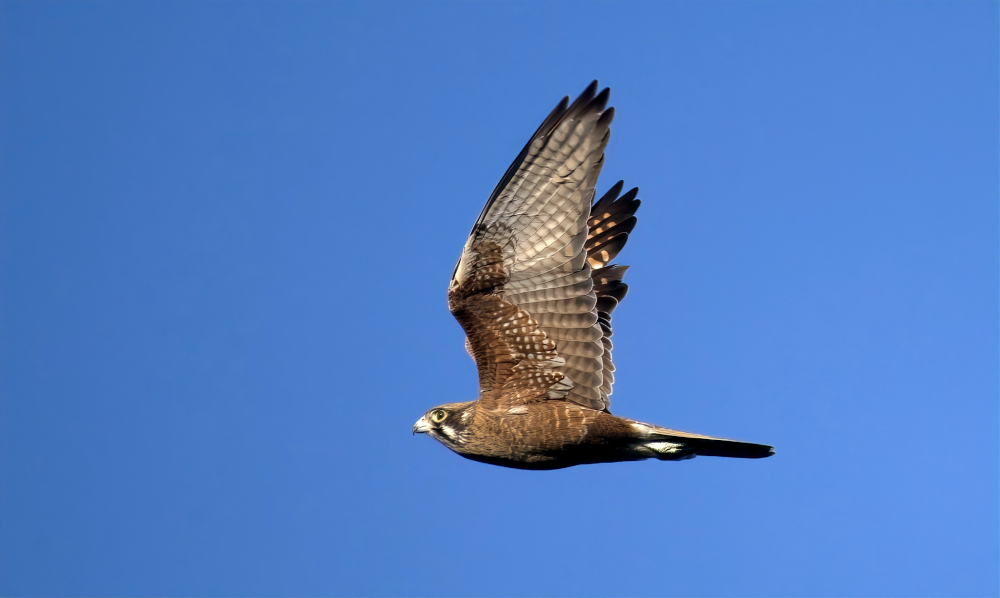Aviceda Wildlife Video
-

Brown Falcon too near to their nest
Around mid-November 2023 I heard a ‘commotion’ from my barn, and noticed an adult Brown Falcon (Falco berigora) perched at the apex of a large Hoop Pine to the south. It was being ‘relentlessly’ attacked by a pair of Australian Magpies (Gymnorhina tibicen) who obviously had a nest nearby. Fortunately I had a camera and…
-

Oriental Pratincoles in SE Queensland
In December 2022 I was fortunate to be invited to participate in a bird-count at the Seven-mile Lagoon at Lockyer Waters on the Yuggara – Ugarapul ancestral land. Fortunately this coincided with reports of several Oriental Pratincole (Glareola maldivarum) and I was given permission to obtain footage/photos. I had previously seen the same species on…
-

Cotton Pygmy-Geese
Recently I visited Wappa Dam near Yandina in SE QLD with Linda to try and get some images and video of Cotton Pygmy-goose, we ‘struggled’ with light on the first morning, spending nearly 3 hours trying to get reasonable sunshine on the birds, however were much more successful the next day….we returned later in the…
-

Black-fronted Dotterel
Have been getting some interesting video of this species Elseyornis melanops close to my residence near Rush Creek (Dayboro, SE Qld) This clip was taken hand-held (….without a tripod) hope it’s not too ‘jumpy’. Spring is in the air…..
-

Golden-headed Cisticola
Nice find on my dawn-walk this morning, a Golden-headed Cisticola (Cisticola exilis) singing on the side of Strong Rd.
-

Horsfield’s Bronze-Cuckoo at the barn
Captured this footage of the Horsfield’s Bronze-Cuckoo (Chrysococcyx basalis) in early-November 2021 with a Canon RP and RF 800mm IS F11 hand-held. I think I may have discovered a new ‘martial art-form’, trying to hold a telephoto lens steady whilst several blowflies crawl up and down your bare-legs, and in and out of your facial-orifices,…
-

Shining Bronze-Cuckoo
Recently there has been plenty of Shining Bronze-Cuckoo (Chrysococcyx lucidus) action around my Barn, including quite a few of the ‘nominate’ New Zealand race ‘lucidus’. Unfortunately I haven’t managed to get any video-clips of them at this stage (late-March 2021) but with the new Qld COVID ‘lock-down’….it might just happen!
-

Clearwing Swallowtails
Clearwing Swallowtails (Cressida cressida) It’s rather unusual to get footage of this butterfly as they never seem ‘stationary’ for long. The female is the larger of the two and the older name of ‘Big Greasy’ comes from the transparent appearance of their wings, appearing to be similar to greaseproof paper. They are fairly-common butterflies in…
-

Tawny Grassbird (Cincloramphus timoriensis)
Singing for Christmas at the ‘Barn’, near Dayboro, SE Qld This one was taken two years earlier at ‘The Crossing’, Draper, SE Qld in March 2020
-

Singing Chirruping Wedgebill
Two Chirruping Wedgebills (Psophodes cristatus) were observed singing near the Noccundra Hotel, SWQ Queensland in early-May 2021 whilst I searched in vain for Grey Grasswren (Amytornis barbatus). Unfortunately this clip was filmed without a tripod but hope it’s not too ‘shaky’.
Got any book recommendations?

